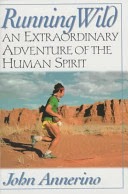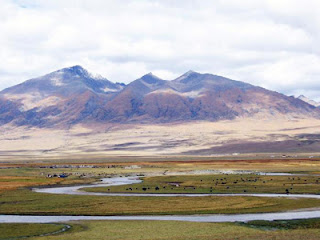Running the inner Grand Canyon: John Annerino's quest
John Annerino. Running Wild, An Extraordinary Adventure of the Human Spirit. New York: Thunder's Mouth Press, 1992, 1998.
Annerino's motivations for undertaking these unprecedented journeys on foot were at the outset unclear even to himself. Never reticent about dramatizing the private, he recounts a colorfully failed engagement (probably for the best), a climbing injury that nearly kills him and then nearly takes his legs, and a vague disaffection with modern culture, including the "running boom," still in its early stages, being hyped in ever larger and more commercial venues.
Ultrarunners often begin by running away from as much as running towards something. An emotional mess before his journey, as his Canyon trilogy progresses, Annerino seems to leave his personal demons behind.
What does he find out there? It is the inner landscape that unfolds most revealingly. Annerino comes to the end of each run on fire with a quest to know, to reimagine, to reconstruct and relive at personal level the experience of the "Anasazi," ancient inhabitants of the Canyon. (Since his book was published, the term "Anasazi," or "ancient enemy" in Navajo, has fallen out of favor, because the Hopi consider these people to be their ancestors.)
Gradually at first and then ever more firmly as his narrative progresses, Annerino's running aims at a single question: could the Kaibab, Hopi, and their ancestors have run the inner Canyon as one leg of a grander 1100 mile trade route that stretched from the California to New Mexico?
The answer appears to be yes.
Starting in the spring of 1980, the first of his three runs takes him along the South Rim, along the rugged Tonto Trail. Along the way, his foot swells and becomes a ball of pain, and he suffers from nausea, dry heaves, and the painful knowledge of the distance he still has to cover. Annerino awakes on day 3 feeling as if he's been "eaten by a wolf and shit over a cliff."
Gradually, running improves and pain subsides for long stretches at a time (as all ultrarunners know, it always returns). As he frees himself from fixation on his own suffering, Annerino's narrative begins to toggle between the extreme conditions in real-time, and the time-travelling vision fueled by his research on Native American traditions of running. Space as well as time becomes jumbled. Thoughts come to him of Eastern traditions such as the lung gompas of Tibet described by David Neel and Lama Govinda.
Daunting as the South Rim and Tonto trail had been, this is a mere warm up for the run Annerino has planned for the spring of 1981.
The Hopi-Havasupai trail proves to be, in the end, a desperate and dangerous struggle for suvival. It is less a "trail" than an idea, a leap in the dark. A trade route may once have existed, but any trace has been scribbled over by centuries of wagon ruts and, more recently, the erosive tracks of pickup trucks. Other times, Annerino and his crew find themselves following a trail that is "no more than a desert bighorn sheep path mashed into a forty-five-dgree slope...the most exposed and dangerous trail any of us has ever been on."
The desert days are broiling, the nights frigid. Sleep on one particular night involves perching on a "slippery ledge without sliding into the brink or dying of exposure." But day after harrowing day, he somehow finds a way forward. Was this a trade route followed by ancient runners? It seems incredible, and yet, when we remember the astonishing accomplishments documented in Peter Nabokov's 'Indian Running'--published in 1981, the same year as Annerino's Hopi-Havasupai run--just possible.
In 1982, Annerino undertakes the third and final of his Canyon runs. The North Rim route is a trek of 250 miles, of which fewer than 50 are on anything that could reasonably be termed a "trail." This will be the most remote, extensive, and topographically challenging of his Canyon runs. He will need to cover it with almost no logistical support. His crew will have little access.
Annerino nearly drowns, nearly freezes to death, and barely escapes a rattlesnake bite. Naturally, it is the most exhilerating and enlightening of the three runs. As he goes deeper and deeper into this rugged terrain, he runs backward in time. With ever more clarity he imagines, hears, and nearly sees a Canyon of centuries ago, one that is much more populous than today, with ancient runners following traditions of that are preserved, perhaps, by the Tarahumara of Mexico, who reportedly cover as much as 200 miles in their 48-hour kickball contests through the barrancas of the Sierra Madre.
Annerino tells us it takes a decade or so for him to absorb the meaning of his experience running the Grand Canyon. In the years immediately following his North Rim run in 1982, he avoids returning to the Canyon trails. It is too much. When at last he is ready to see them again, he comes in company with his wife and children, gathering safely in areas designated for tourists.
Something rather mystical happens in that return visit. I won't give it away--spoilers. Suffice to say that Annerino leaves with a firm sense of the path he needs to continue following for the rest of his life. Now a noted photographer and chronicleer of the Southwest region, he appears to have done just that (http://www.johnannerino.com/).
Thirty years ago, John Annerino--avid climber, runner, and sometime instructor at a community college
in southern Arizona--ran the length of the Grand Canyon. He did so three times during the early 1980s, each attempt following a path more remote and arduous than the previous.
in southern Arizona--ran the length of the Grand Canyon. He did so three times during the early 1980s, each attempt following a path more remote and arduous than the previous.
Running away and running toward
Annerino's motivations for undertaking these unprecedented journeys on foot were at the outset unclear even to himself. Never reticent about dramatizing the private, he recounts a colorfully failed engagement (probably for the best), a climbing injury that nearly kills him and then nearly takes his legs, and a vague disaffection with modern culture, including the "running boom," still in its early stages, being hyped in ever larger and more commercial venues.
Ultrarunners often begin by running away from as much as running towards something. An emotional mess before his journey, as his Canyon trilogy progresses, Annerino seems to leave his personal demons behind.
What does he find out there? It is the inner landscape that unfolds most revealingly. Annerino comes to the end of each run on fire with a quest to know, to reimagine, to reconstruct and relive at personal level the experience of the "Anasazi," ancient inhabitants of the Canyon. (Since his book was published, the term "Anasazi," or "ancient enemy" in Navajo, has fallen out of favor, because the Hopi consider these people to be their ancestors.)
Gradually at first and then ever more firmly as his narrative progresses, Annerino's running aims at a single question: could the Kaibab, Hopi, and their ancestors have run the inner Canyon as one leg of a grander 1100 mile trade route that stretched from the California to New Mexico?
The answer appears to be yes.
"Eaten by a wolf and shit over a cliff"
Starting in the spring of 1980, the first of his three runs takes him along the South Rim, along the rugged Tonto Trail. Along the way, his foot swells and becomes a ball of pain, and he suffers from nausea, dry heaves, and the painful knowledge of the distance he still has to cover. Annerino awakes on day 3 feeling as if he's been "eaten by a wolf and shit over a cliff."
Gradually, running improves and pain subsides for long stretches at a time (as all ultrarunners know, it always returns). As he frees himself from fixation on his own suffering, Annerino's narrative begins to toggle between the extreme conditions in real-time, and the time-travelling vision fueled by his research on Native American traditions of running. Space as well as time becomes jumbled. Thoughts come to him of Eastern traditions such as the lung gompas of Tibet described by David Neel and Lama Govinda.
The Hopi-Havasupai Trail, 1981
Daunting as the South Rim and Tonto trail had been, this is a mere warm up for the run Annerino has planned for the spring of 1981.
The Hopi-Havasupai trail proves to be, in the end, a desperate and dangerous struggle for suvival. It is less a "trail" than an idea, a leap in the dark. A trade route may once have existed, but any trace has been scribbled over by centuries of wagon ruts and, more recently, the erosive tracks of pickup trucks. Other times, Annerino and his crew find themselves following a trail that is "no more than a desert bighorn sheep path mashed into a forty-five-dgree slope...the most exposed and dangerous trail any of us has ever been on."
The desert days are broiling, the nights frigid. Sleep on one particular night involves perching on a "slippery ledge without sliding into the brink or dying of exposure." But day after harrowing day, he somehow finds a way forward. Was this a trade route followed by ancient runners? It seems incredible, and yet, when we remember the astonishing accomplishments documented in Peter Nabokov's 'Indian Running'--published in 1981, the same year as Annerino's Hopi-Havasupai run--just possible.
North Rim, 1982
In 1982, Annerino undertakes the third and final of his Canyon runs. The North Rim route is a trek of 250 miles, of which fewer than 50 are on anything that could reasonably be termed a "trail." This will be the most remote, extensive, and topographically challenging of his Canyon runs. He will need to cover it with almost no logistical support. His crew will have little access.
Annerino nearly drowns, nearly freezes to death, and barely escapes a rattlesnake bite. Naturally, it is the most exhilerating and enlightening of the three runs. As he goes deeper and deeper into this rugged terrain, he runs backward in time. With ever more clarity he imagines, hears, and nearly sees a Canyon of centuries ago, one that is much more populous than today, with ancient runners following traditions of that are preserved, perhaps, by the Tarahumara of Mexico, who reportedly cover as much as 200 miles in their 48-hour kickball contests through the barrancas of the Sierra Madre.
Aftermath and the way forward
Annerino tells us it takes a decade or so for him to absorb the meaning of his experience running the Grand Canyon. In the years immediately following his North Rim run in 1982, he avoids returning to the Canyon trails. It is too much. When at last he is ready to see them again, he comes in company with his wife and children, gathering safely in areas designated for tourists.
Something rather mystical happens in that return visit. I won't give it away--spoilers. Suffice to say that Annerino leaves with a firm sense of the path he needs to continue following for the rest of his life. Now a noted photographer and chronicleer of the Southwest region, he appears to have done just that (http://www.johnannerino.com/).






Comments
Post a Comment